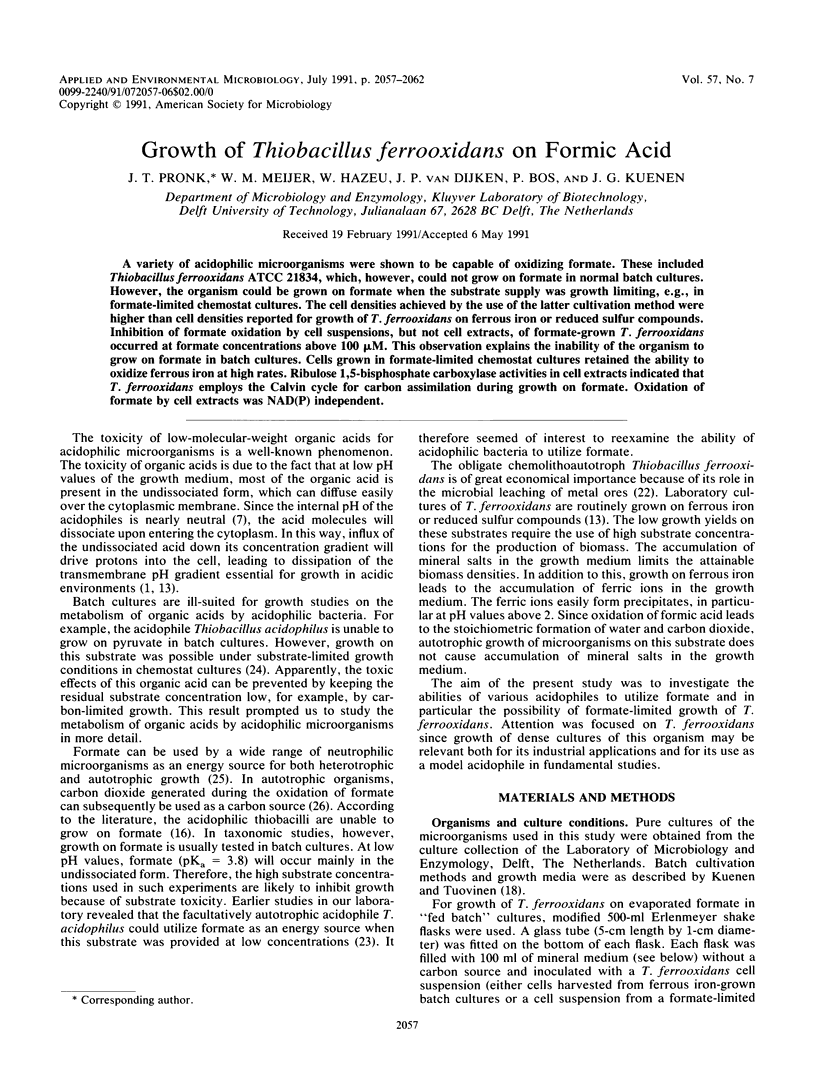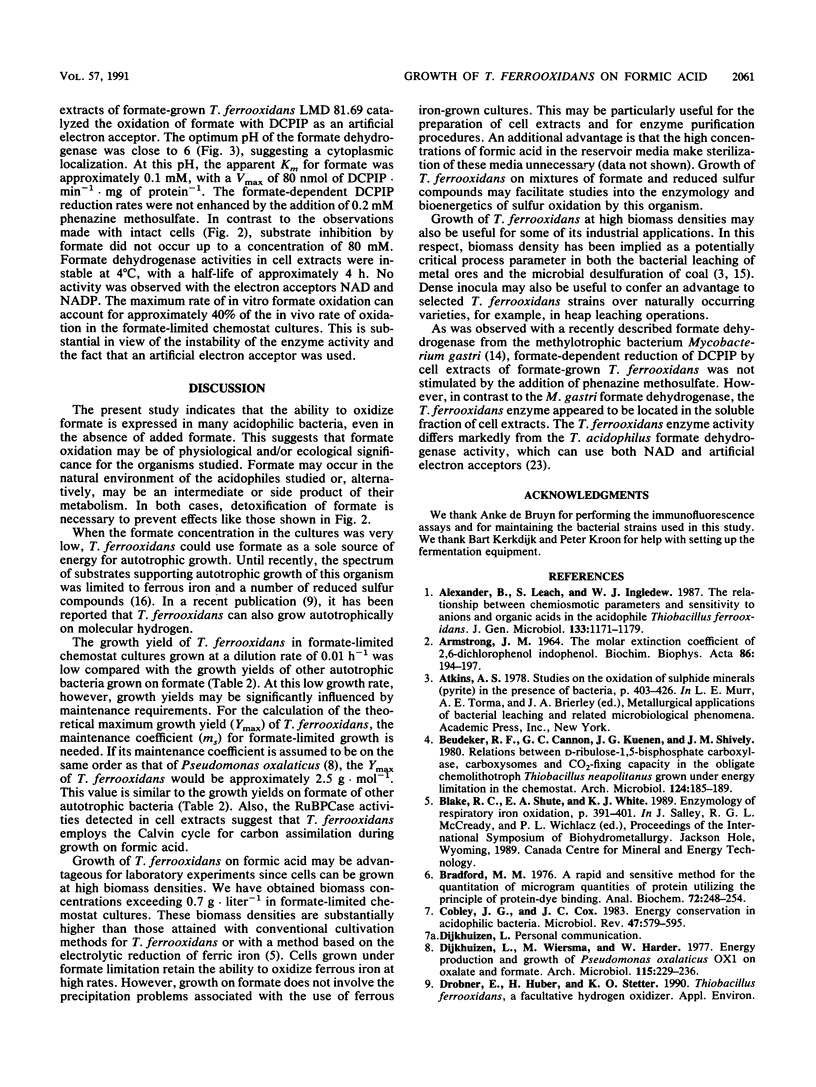Abstract
A variety of acidophilic microorganisms were shown to be capable of oxidizing formate. These included Thiobacillus ferrooxidans ATCC 21834, which, however, could not grow on formate in normal batch cultures. However, the organism could be grown on formate when the substrate supply was growth limiting, e.g., in formate-limited chemostat cultures. The cell densities achieved by the use of the latter cultivation method were higher than cell densities reported for growth of T. ferrooxidans on ferrous iron or reduced sulfur compounds. Inhibition of formate oxidation by cell suspensions, but not cell extracts, of formate-grown T. ferrooxidans occurred at formate concentrations above 100 μM. This observation explains the inability of the organism to grow on formate in batch cultures. Cells grown in formate-limited chemostat cultures retained the ability to oxidize ferrous iron at high rates. Ribulose 1,5-bisphosphate carboxylase activities in cell extracts indicated that T. ferrooxidans employs the Calvin cycle for carbon assimilation during growth on formate. Oxidation of formate by cell extracts was NAD(P) independent.
Full text
PDF





Selected References
These references are in PubMed. This may not be the complete list of references from this article.
- ARMSTRONG J. M. THE MOLAR EXTINCTION COEFFICIENT OF 2,6-DICHLOROPHENOL INDOPHENOL. Biochim Biophys Acta. 1964 Apr 4;86:194–197. doi: 10.1016/0304-4165(64)90180-1. [DOI] [PubMed] [Google Scholar]
- Bradford M. M. A rapid and sensitive method for the quantitation of microgram quantities of protein utilizing the principle of protein-dye binding. Anal Biochem. 1976 May 7;72:248–254. doi: 10.1016/0003-2697(76)90527-3. [DOI] [PubMed] [Google Scholar]
- Cobley J. G., Cox J. C. Energy conservation in acidophilic bacteria. Microbiol Rev. 1983 Dec;47(4):579–595. doi: 10.1128/mr.47.4.579-595.1983. [DOI] [PMC free article] [PubMed] [Google Scholar]
- Dijkhuizen L., Wiersma M., Harder W. Energy production and growth of Pseudomonas oxalaticus OX1 on oxalate and formate. Arch Microbiol. 1977 Nov 18;115(2):229–236. doi: 10.1007/BF00406379. [DOI] [PubMed] [Google Scholar]
- Fox B. G., Froland W. A., Dege J. E., Lipscomb J. D. Methane monooxygenase from Methylosinus trichosporium OB3b. Purification and properties of a three-component system with high specific activity from a type II methanotroph. J Biol Chem. 1989 Jun 15;264(17):10023–10033. [PubMed] [Google Scholar]
- Hazeu W., Bijleveld W., Grotenhuis J. T., Kakes E., Kuenen J. G. Kinetics and energetics of reduced sulfur oxidation by chemostat cultures of Thiobacillus ferrooxidans. Antonie Van Leeuwenhoek. 1986;52(6):507–518. doi: 10.1007/BF00423411. [DOI] [PubMed] [Google Scholar]
- Ingledew W. J. Thiobacillus ferrooxidans. The bioenergetics of an acidophilic chemolithotroph. Biochim Biophys Acta. 1982 Nov 30;683(2):89–117. doi: 10.1016/0304-4173(82)90007-6. [DOI] [PubMed] [Google Scholar]
- Muyzer G., de Bruyn A. C., Schmedding D. J., Bos P., Westbroek P., Kuenen G. J. A Combined Immunofluorescence-DNA-Fluorescence Staining Technique for Enumeration of Thiobacillus ferrooxidans in a Population of Acidophilic Bacteria. Appl Environ Microbiol. 1987 Apr;53(4):660–664. doi: 10.1128/aem.53.4.660-664.1987. [DOI] [PMC free article] [PubMed] [Google Scholar]
- QUAYLE J. R., KEECH D. B. Carbon assimilation by Pseudomonas oxalaticus (OX 1). 2. Formate and carbon dioxide utilization by cell-free extracts of the organism grown on formate. Biochem J. 1959 Aug;72:631–637. doi: 10.1042/bj0720631. [DOI] [PMC free article] [PubMed] [Google Scholar]
- Van Urk H., Mak P. R., Scheffers W. A., van Dijken J. P. Metabolic responses of Saccharomyces cerevisiae CBS 8066 and Candida utilis CBS 621 upon transition from glucose limitation to glucose excess. Yeast. 1988 Dec;4(4):283–291. doi: 10.1002/yea.320040406. [DOI] [PubMed] [Google Scholar]
- van Verseveld H. W., Stouthamer A. H. Growth yields and the efficiency of oxidative phosphorylation during autotrophic growth of Paracoccus denitrificans on methanol and formate. Arch Microbiol. 1978 Jul;118(1):21–26. doi: 10.1007/BF00406069. [DOI] [PubMed] [Google Scholar]


